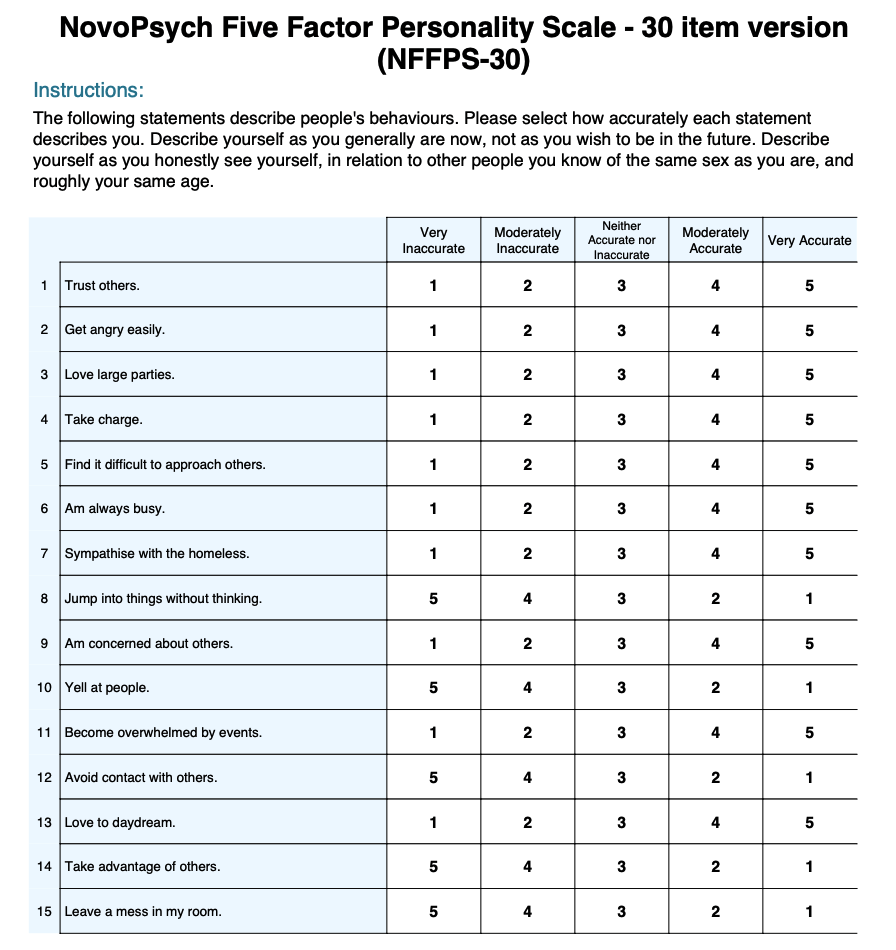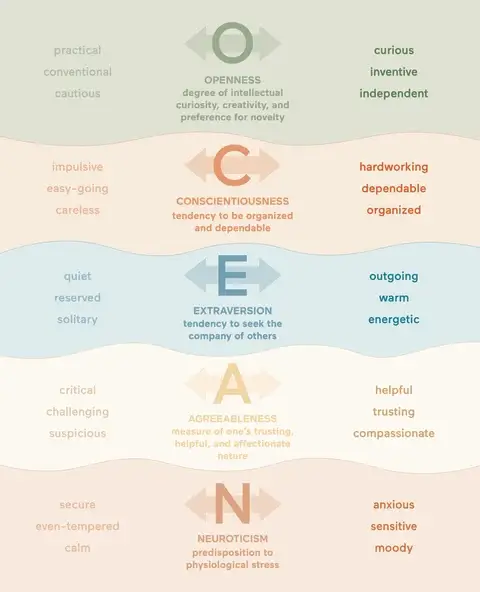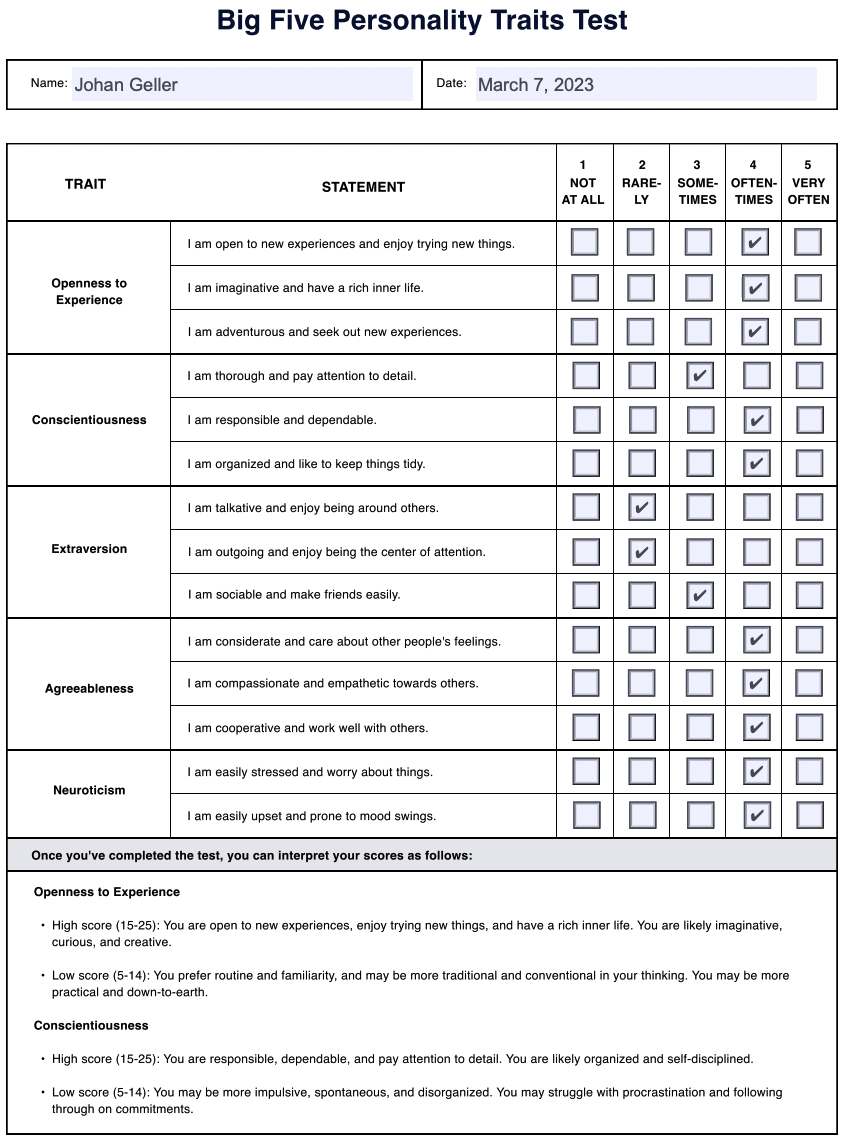Five Factors of Personality
Explore the Five-Factor Model (FFM) of personality: openness, conscientiousness, extraversion, agreeableness, and neuroticism. Learn about its history, applications, and criticisms.


Explore the Five-Factor Model (FFM) of personality: openness, conscientiousness, extraversion, agreeableness, and neuroticism. Learn about its history, applications, and criticisms.
The Five-Factor Model (FFM) offers a comprehensive framework for understanding human personality, structured around five broad dimensions. This model, deeply rooted in academic psychology, has been widely endorsed by personality psychologists for its efficacy in categorizing patterns of behavior and thought.
It emerged from the work of researchers like Raymond Cattell, who initially identified a broad range of traits, and Lewis Goldberg, who later refined them into five major dimensions. These dimensions are used to describe the full spectrum of human personality, offering insights into individual differences and how these traits influence one's life.
Personality tests based on the FFM can provide valuable information about a person's emotional stability, impulse control, and social interaction preferences, among other characteristics. For instance, such tests can distinguish between individuals who are naturally agreeable and those who tend to seek the center of attention, or between conscientious people and those more prone to emotional instability.
Understanding these differences is crucial, not just in academic settings but also in everyday life, as it affects everything from childhood temperaments to adult relationships and workplace dynamics.
The model's five basic dimensions are:
These dimensions form the cornerstone of the FFM, providing a lens through which personality psychologists view human behavior. They encapsulate a wide range of human experiences and traits, from classic temperament traits identified in childhood to complex differences in adult personality patterns. This model has been extensively documented in reputable sources such as the Journal of Personality and the Journal of Personality and Social Psychology, underscoring its significance in the study of personality differences.
Understanding personality traits is crucial in various aspects of life, including candidate selection, workplace relationships, and work-life balance. The Big 5 personality traits - extraversion, agreeableness, openness, conscientiousness, and neuroticism - provide a framework for understanding individual characteristics and their impact on different life indicators.
In candidate selection, knowing a candidate's personality traits can help in determining whether they are a good fit for the organization, team, and role. It can also aid in predicting their job performance, communication style, and overall work behavior.
In workplace relationships, understanding personality traits can foster better communication, collaboration, and conflict resolution. For example, being aware of one's own and others’ levels of agreeableness can help in navigating interpersonal dynamics and managing team interactions more effectively.
In terms of work-life balance, being mindful of one's own personality traits can aid in achieving a healthier balance between professional and personal life. For instance, being conscientious can help in time management and goal-setting for better work-life integration.
Overall, understanding personality traits, particularly the Big 5, is essential for making informed decisions in various contexts, such as candidate selection, workplace relationships, and work-life balance.

The history and development of the Five-Factor Model (FFM) of personality represent a significant journey in the field of psychology, tracing the evolution of understanding personality dimensions.
This journey begins in the early 20th century, with the pioneering work of psychologists who sought to categorize human traits into a manageable framework. Initial efforts were fragmented, focusing on a wide array of traits without a unified system. The significant leap towards the FFM occurred in the 1960s, thanks to Raymond Cattell's factor analysis, which distilled personality traits into a smaller number of dimensions.
However, it was not until the 1980s that Lewis Goldberg proposed the term "Big Five" to describe these broad factors, solidifying the model into the five broad personality traits recognized today: Openness, Conscientiousness, Extraversion, Agreeableness, and Neuroticism.
This model has been refined and validated through decades of research, including countless personality profiles and studies published in journals such as the Journal of Research in Personality, Journal of Personality, and the Journal of Personality and Social Psychology.
These studies have consistently shown the FFM's efficacy in predicting patterns of behavior and individual differences across various contexts and cultures. The model's emphasis on broad trait dimensions allows for a comprehensive understanding of personality, encompassing everything from impulse control and attention to details to the relationship between openness and creativity.
The FFM is characterized by:
Through its development, the FFM has become a cornerstone of personality theories, offering insights into how broad factors shape our lives, from interpersonal relationships to professional environments. Its chronological development showcases the field's progression towards a more nuanced understanding of personality, highlighting the importance of both broad and specific traits in capturing the complexity of human behavior.
| Personality Trait | Description |
|---|---|
| Openness to Experience | The extent to which a person is open to new ideas, experiences, and intellectual curiosity. High scorers tend to be creative and adventurous, while low scorers may be more traditional and cautious. |
| Conscientiousness | Refers to the degree of organization, responsibility, and goal-directed behavior in a person. High scorers are typically organized and reliable, while low scorers may be more impulsive and disorganized. |
| Extraversion | Measures the level of sociability, assertiveness, and outgoingness in an individual. High scorers are often sociable and energetic, while low scorers may be introverted and reserved. |
| Agreeableness | Reflects a person's tendency to be cooperative, compassionate, and considerate towards others. High scorers are usually warm and empathetic, while low scorers may be more competitive and skeptical. |
| Neuroticism | Evaluates the degree of emotional stability and negative emotional reactions in an individual. High scorers may experience anxiety and mood swings, while low scorers tend to be more emotionally stable and calm. |
As we have seen, the Five-Factor Model (FFM) of personality encompasses five broad dimensions that serve as the foundation for understanding human personality and behavior. Each dimension represents a spectrum of traits that capture the complexity and diversity of human characteristics.
Openness to experience is characterized by a willingness to explore new ideas, experiences, and creative pursuits. Individuals high in this trait exhibit a rich imagination, a strong sense of curiosity about the world, and an appreciation for art and beauty.
They are more likely to engage in novel and varied activities, demonstrating a broad range of interests. This dimension reflects not just a tolerance for the unfamiliar but an active pursuit of experiences that expand one's perspective and capabilities.
Conscientiousness describes a person's degree of organization, dependability, and diligence. Highly conscientious individuals are methodical, responsible, and reliable. They exhibit a strong sense of duty, showing discipline in their tasks and commitments.
This trait is associated with the ability to set and achieve long-term goals, meticulous attention to detail, and a preference for planning over spontaneity. Conscientiousness is a strong predictor of academic and professional success, reflecting the importance of self-discipline and management skills.

Extraversion is marked by energy, sociability, and a tendency to seek out social interactions. Extraverts are often described as outgoing, talkative, and lively. They thrive in social situations, drawing energy from being around others and engaging in conversation.
This dimension encompasses enthusiasm for life, assertiveness, and the experience of positive emotions. Extraverts are typically more comfortable in the center of attention and are adept at navigating social landscapes, making connections easily.
Agreeableness reflects a person's orientation towards cooperation, social harmony, and concern for others. Agreeable individuals are compassionate, trusting, and altruistic. They value social cohesion, often putting the needs of others above their own, and are more likely to engage in prosocial behaviors.
This trait is associated with a tendency to avoid conflicts, showing empathy and support towards others, and maintaining positive relationships. Agreeableness contributes to the capacity for teamwork and understanding in social interactions.
Neuroticism indicates a predisposition to experience negative emotions, such as anxiety, depression, and anger, more frequently and intensely than others. Individuals with high levels of neuroticism may have less emotional stability and are more susceptible to stress.
This dimension encompasses emotional sensitivity and the tendency to respond to stressors with negative emotions. It can affect an individual's ability to cope with life's challenges, influencing their mental health and overall well-being. Neuroticism provides insight into the variability of emotional responses among individuals, highlighting the significance of emotional regulation and resilience.
Together, these five dimensions offer a comprehensive framework for understanding the vast array of human personalities. By examining where individuals fall on each of these spectrums, psychologists can gain a deeper insight into their behaviors, preferences, and life outcomes.

Despite the widespread acceptance and application of the Five-Factor Model (FFM) in understanding personality differences, it has not been without its criticisms and controversies. Scholars and practitioners alike have voiced concerns regarding the model's limitations and assumptions.
One of the primary critiques centers on the model's perceived inability to account for the nuances of human personality fully, including the impact of situational variables on behavior. Critics argue that the FFM, while providing a useful framework for categorizing broad personality traits, may oversimplify the complexity of human emotions and behaviors, neglecting the influence of context and environment.
Moreover, the emphasis on broad traits like agreeableness has been challenged by findings from longitudinal studies and previous research indicating that personality can evolve over time, influenced by life experiences and changing circumstances.
This suggests a dynamic aspect of personality that fixed models may not capture. Additionally, the methodology behind the FFM, primarily derived from self-reported data, raises questions about the reliability and validity of the results, with some suggesting that these methods are prone to bias and inaccuracies.
Lewis Goldberg, a proponent of the FFM, along with others in the field, have engaged in ongoing debates documented in the Journal of Research in Personality and other academic platforms. These discussions often highlight the need for integrating situational variables and considering the fluidity of personality over time. The model's critics advocate for a more nuanced approach that includes:
These points of contention underscore the ongoing dialogue within the field regarding the best ways to conceptualize and measure personality. While the FFM provides a foundational framework, the debates and criticisms enrich the discussion, driving forward advancements in personality psychology.

Factor analysis is a statistical technique used in psychology to identify and define personality factors. Researchers in the field have established hierarchical structural models to understand the underlying dimensions of personality. This method helps in uncovering the underlying factors that explain the variations in people's personalities.
Personality traits are influenced by both biological and environmental factors. Twin studies have shown that the big five personality traits, including openness, conscientiousness, extraversion, agreeableness, and neuroticism, have a significant heritability component. This means that genetics play a role in shaping these traits.
Factors such as maturation also influence personality traits. As people grow and develop, their personalities may change in response to life experiences and social interactions. Understanding these influences is essential in comprehending the complexities of human personality.
In sum, factor analysis is instrumental in identifying and defining personality factors through the examination of hierarchical structural models. It provides insights into the roles of biological and environmental influences, as well as the impact of maturation on personality traits.
The Five-Factor Model (FFM) of personality has versatile applications across various domains, demonstrating its utility in understanding and predicting a wide range of behaviors and outcomes. Here are seven practical applications of the model:
These applications underscore the FFM's broad utility in practical settings, from enhancing educational and workplace outcomes to informing interventions for mental health and facilitating a deeper understanding of the development of personality across the lifespan.
By leveraging insights from the FFM, professionals across disciplines can better address individual differences, tailoring their approaches to meet the unique needs and strengths of those they serve.

Here are five key studies on the Five Factors of Personality Theory, focusing on various aspects and implications of the theory:
These studies collectively offer a comprehensive view of the Five Factor Model of Personality, covering its theoretical foundation, applications in understanding human behavior and personality development, and the interplay between genetic and environmental factors in shaping personality traits.
The Five-Factor Model (FFM) offers a comprehensive framework for understanding human personality, structured around five broad dimensions. This model, deeply rooted in academic psychology, has been widely endorsed by personality psychologists for its efficacy in categorizing patterns of behavior and thought.
It emerged from the work of researchers like Raymond Cattell, who initially identified a broad range of traits, and Lewis Goldberg, who later refined them into five major dimensions. These dimensions are used to describe the full spectrum of human personality, offering insights into individual differences and how these traits influence one's life.
Personality tests based on the FFM can provide valuable information about a person's emotional stability, impulse control, and social interaction preferences, among other characteristics. For instance, such tests can distinguish between individuals who are naturally agreeable and those who tend to seek the center of attention, or between conscientious people and those more prone to emotional instability.
Understanding these differences is crucial, not just in academic settings but also in everyday life, as it affects everything from childhood temperaments to adult relationships and workplace dynamics.
The model's five basic dimensions are:
These dimensions form the cornerstone of the FFM, providing a lens through which personality psychologists view human behavior. They encapsulate a wide range of human experiences and traits, from classic temperament traits identified in childhood to complex differences in adult personality patterns. This model has been extensively documented in reputable sources such as the Journal of Personality and the Journal of Personality and Social Psychology, underscoring its significance in the study of personality differences.
Understanding personality traits is crucial in various aspects of life, including candidate selection, workplace relationships, and work-life balance. The Big 5 personality traits - extraversion, agreeableness, openness, conscientiousness, and neuroticism - provide a framework for understanding individual characteristics and their impact on different life indicators.
In candidate selection, knowing a candidate's personality traits can help in determining whether they are a good fit for the organization, team, and role. It can also aid in predicting their job performance, communication style, and overall work behavior.
In workplace relationships, understanding personality traits can foster better communication, collaboration, and conflict resolution. For example, being aware of one's own and others’ levels of agreeableness can help in navigating interpersonal dynamics and managing team interactions more effectively.
In terms of work-life balance, being mindful of one's own personality traits can aid in achieving a healthier balance between professional and personal life. For instance, being conscientious can help in time management and goal-setting for better work-life integration.
Overall, understanding personality traits, particularly the Big 5, is essential for making informed decisions in various contexts, such as candidate selection, workplace relationships, and work-life balance.

The history and development of the Five-Factor Model (FFM) of personality represent a significant journey in the field of psychology, tracing the evolution of understanding personality dimensions.
This journey begins in the early 20th century, with the pioneering work of psychologists who sought to categorize human traits into a manageable framework. Initial efforts were fragmented, focusing on a wide array of traits without a unified system. The significant leap towards the FFM occurred in the 1960s, thanks to Raymond Cattell's factor analysis, which distilled personality traits into a smaller number of dimensions.
However, it was not until the 1980s that Lewis Goldberg proposed the term "Big Five" to describe these broad factors, solidifying the model into the five broad personality traits recognized today: Openness, Conscientiousness, Extraversion, Agreeableness, and Neuroticism.
This model has been refined and validated through decades of research, including countless personality profiles and studies published in journals such as the Journal of Research in Personality, Journal of Personality, and the Journal of Personality and Social Psychology.
These studies have consistently shown the FFM's efficacy in predicting patterns of behavior and individual differences across various contexts and cultures. The model's emphasis on broad trait dimensions allows for a comprehensive understanding of personality, encompassing everything from impulse control and attention to details to the relationship between openness and creativity.
The FFM is characterized by:
Through its development, the FFM has become a cornerstone of personality theories, offering insights into how broad factors shape our lives, from interpersonal relationships to professional environments. Its chronological development showcases the field's progression towards a more nuanced understanding of personality, highlighting the importance of both broad and specific traits in capturing the complexity of human behavior.
| Personality Trait | Description |
|---|---|
| Openness to Experience | The extent to which a person is open to new ideas, experiences, and intellectual curiosity. High scorers tend to be creative and adventurous, while low scorers may be more traditional and cautious. |
| Conscientiousness | Refers to the degree of organization, responsibility, and goal-directed behavior in a person. High scorers are typically organized and reliable, while low scorers may be more impulsive and disorganized. |
| Extraversion | Measures the level of sociability, assertiveness, and outgoingness in an individual. High scorers are often sociable and energetic, while low scorers may be introverted and reserved. |
| Agreeableness | Reflects a person's tendency to be cooperative, compassionate, and considerate towards others. High scorers are usually warm and empathetic, while low scorers may be more competitive and skeptical. |
| Neuroticism | Evaluates the degree of emotional stability and negative emotional reactions in an individual. High scorers may experience anxiety and mood swings, while low scorers tend to be more emotionally stable and calm. |
As we have seen, the Five-Factor Model (FFM) of personality encompasses five broad dimensions that serve as the foundation for understanding human personality and behavior. Each dimension represents a spectrum of traits that capture the complexity and diversity of human characteristics.
Openness to experience is characterized by a willingness to explore new ideas, experiences, and creative pursuits. Individuals high in this trait exhibit a rich imagination, a strong sense of curiosity about the world, and an appreciation for art and beauty.
They are more likely to engage in novel and varied activities, demonstrating a broad range of interests. This dimension reflects not just a tolerance for the unfamiliar but an active pursuit of experiences that expand one's perspective and capabilities.
Conscientiousness describes a person's degree of organization, dependability, and diligence. Highly conscientious individuals are methodical, responsible, and reliable. They exhibit a strong sense of duty, showing discipline in their tasks and commitments.
This trait is associated with the ability to set and achieve long-term goals, meticulous attention to detail, and a preference for planning over spontaneity. Conscientiousness is a strong predictor of academic and professional success, reflecting the importance of self-discipline and management skills.

Extraversion is marked by energy, sociability, and a tendency to seek out social interactions. Extraverts are often described as outgoing, talkative, and lively. They thrive in social situations, drawing energy from being around others and engaging in conversation.
This dimension encompasses enthusiasm for life, assertiveness, and the experience of positive emotions. Extraverts are typically more comfortable in the center of attention and are adept at navigating social landscapes, making connections easily.
Agreeableness reflects a person's orientation towards cooperation, social harmony, and concern for others. Agreeable individuals are compassionate, trusting, and altruistic. They value social cohesion, often putting the needs of others above their own, and are more likely to engage in prosocial behaviors.
This trait is associated with a tendency to avoid conflicts, showing empathy and support towards others, and maintaining positive relationships. Agreeableness contributes to the capacity for teamwork and understanding in social interactions.
Neuroticism indicates a predisposition to experience negative emotions, such as anxiety, depression, and anger, more frequently and intensely than others. Individuals with high levels of neuroticism may have less emotional stability and are more susceptible to stress.
This dimension encompasses emotional sensitivity and the tendency to respond to stressors with negative emotions. It can affect an individual's ability to cope with life's challenges, influencing their mental health and overall well-being. Neuroticism provides insight into the variability of emotional responses among individuals, highlighting the significance of emotional regulation and resilience.
Together, these five dimensions offer a comprehensive framework for understanding the vast array of human personalities. By examining where individuals fall on each of these spectrums, psychologists can gain a deeper insight into their behaviors, preferences, and life outcomes.

Despite the widespread acceptance and application of the Five-Factor Model (FFM) in understanding personality differences, it has not been without its criticisms and controversies. Scholars and practitioners alike have voiced concerns regarding the model's limitations and assumptions.
One of the primary critiques centers on the model's perceived inability to account for the nuances of human personality fully, including the impact of situational variables on behavior. Critics argue that the FFM, while providing a useful framework for categorizing broad personality traits, may oversimplify the complexity of human emotions and behaviors, neglecting the influence of context and environment.
Moreover, the emphasis on broad traits like agreeableness has been challenged by findings from longitudinal studies and previous research indicating that personality can evolve over time, influenced by life experiences and changing circumstances.
This suggests a dynamic aspect of personality that fixed models may not capture. Additionally, the methodology behind the FFM, primarily derived from self-reported data, raises questions about the reliability and validity of the results, with some suggesting that these methods are prone to bias and inaccuracies.
Lewis Goldberg, a proponent of the FFM, along with others in the field, have engaged in ongoing debates documented in the Journal of Research in Personality and other academic platforms. These discussions often highlight the need for integrating situational variables and considering the fluidity of personality over time. The model's critics advocate for a more nuanced approach that includes:
These points of contention underscore the ongoing dialogue within the field regarding the best ways to conceptualize and measure personality. While the FFM provides a foundational framework, the debates and criticisms enrich the discussion, driving forward advancements in personality psychology.

Factor analysis is a statistical technique used in psychology to identify and define personality factors. Researchers in the field have established hierarchical structural models to understand the underlying dimensions of personality. This method helps in uncovering the underlying factors that explain the variations in people's personalities.
Personality traits are influenced by both biological and environmental factors. Twin studies have shown that the big five personality traits, including openness, conscientiousness, extraversion, agreeableness, and neuroticism, have a significant heritability component. This means that genetics play a role in shaping these traits.
Factors such as maturation also influence personality traits. As people grow and develop, their personalities may change in response to life experiences and social interactions. Understanding these influences is essential in comprehending the complexities of human personality.
In sum, factor analysis is instrumental in identifying and defining personality factors through the examination of hierarchical structural models. It provides insights into the roles of biological and environmental influences, as well as the impact of maturation on personality traits.
The Five-Factor Model (FFM) of personality has versatile applications across various domains, demonstrating its utility in understanding and predicting a wide range of behaviors and outcomes. Here are seven practical applications of the model:
These applications underscore the FFM's broad utility in practical settings, from enhancing educational and workplace outcomes to informing interventions for mental health and facilitating a deeper understanding of the development of personality across the lifespan.
By leveraging insights from the FFM, professionals across disciplines can better address individual differences, tailoring their approaches to meet the unique needs and strengths of those they serve.

Here are five key studies on the Five Factors of Personality Theory, focusing on various aspects and implications of the theory:
These studies collectively offer a comprehensive view of the Five Factor Model of Personality, covering its theoretical foundation, applications in understanding human behavior and personality development, and the interplay between genetic and environmental factors in shaping personality traits.